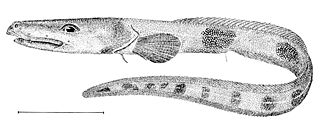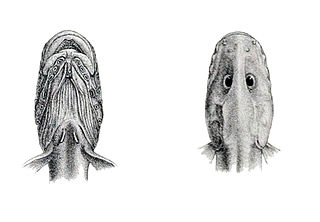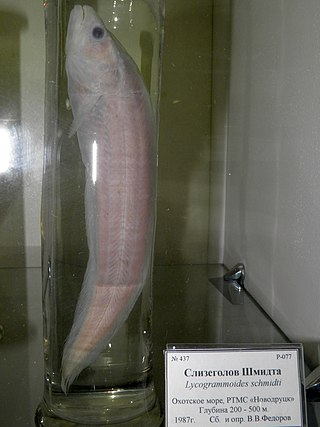
The viviparous eelpout, also known as the, viviparous blenny and European eelpout is species of marine ray-finned fish belonging to the family Zoarcidae, the eelpouts. It is notable for being ovoviviparous and gives birth to live larvae. It is a common soup ingredient in Mediterranean countries. The bones are of greenish colour, due to a harmless pigment. Their skin is slimy and the colour is variable.
Zoarces is a genus of marine ray-finned fishes belonging to the family Zoarcidae, the eelpouts. It is the only genus in the subfamily Zoarcinae. These eelpouts are found in the northern Atlantic and northern Pacific Oceans.

Bothrocara is a genus of marine ray-finned fishes belonging to the family Zoarcidae, the eelpouts. They are found in the Pacific Ocean with one species reaching the southwestern Atlantic Ocean.
Lycodes is a genus of zoarcid fish in the subfamily Lycodinae. It is the most species-rich genus in its taxonomic family as well as in the Arctic Ocean and adjacent waters. They occupy both shallow waters and deeper waters down to 3000 meters. A few species can occur in brackish waters.
Lycodes vahlii, Vahl's eelpout or the checker eelpout, is a species of marine ray-finned fish belonging to the family Zoarcidae, the eelpouts. It is native to coasts of Northern Atlantic Ocean.

Lycodichthys is a genus of marine ray-finned fish belonging to the family Zoarcidae, the eelpouts. They are found in the Southern Ocean.

Lycenchelys is a genus of marine ray-finned fishes belonging to the family Zoarcidae, the eelpouts. The genus has almost cosmopolitan distribution.
Lycodes terraenovae, also called the Newfoundland eelpout, Atlantic eelpout or fish doctor, is a species of marine ray-finned fish belonging to the family Zoarcidae, the eelpouts. It is found in deep waters of the Atlantic Ocean.
Pachycara crassiceps is a species of marine ray-finned fish belonging to the family Zoarcidae, the eelpouts. It is found in the Eastern Atlantic Ocean.
Gymnelinae is a subfamily of marine ray-finned fish belonging to the family Zoarcidae, the eelpouts. Most species are found in the North Pacific Ocean but one genus is cosmopolitan, and another is endemic to the Southern Ocean.
Andriashevia is a monospecific genus of marine ray-finned fish belonging to the subfamiy Gymnelinae of the family Zoarcidae, the eelpouts, its only species is Andriasheevia aptera. It is found in the northwestern Pacific Ocean, where it occurs off the Pacific coast of Japan. It appears to be a demersal fish which is associated with large red gorgonian corals, e.g. Paragorgia. Examinations of the stomach contents of collected specimens has shown that its diet is mainly crustaceans but it likely also feeds on encrusting invertebrates which it searches for among coral branches and the hard substrates they live in. This species attains a maximum published standard length of 19.3 cm (7.6 in). Unlike other species in the subfamily Gymnelinae, this taxon has no pectoral fins. The genus name honours the Soviet ichthyologist Anatoly Petrovich Andriashev for his work on fishes of the Russian Far East and especially eelpouts. The specific name, aptera means "without wings" and refers to the absence of pectoral fins.
Lycodinae is a subfamily of marine ray-finned fish belonging to the family Zoarcidae, the eelpouts. These eelpouts are found are in all the world's oceans, with a number of species being found off southern South America.

Austrolycus is a genus of marine ray-finned fishes belonging to the family Zoarcidae, the eelpouts. The two species in this genus are found in the southeastern Pacific Ocean and the western South Atlantic Ocean off southern South America and the Falkland Islands.

Lycenchelys muraena, the moray wolf eel, is a species of marine ray-finned fish belonging to the family Zoarcidae, the eelpouts. It is found in the Arctic and North Atlantic Oceans.
Lycodes gracilis, Vahl's eelpout or the gracile eelpout, is a species of marine ray-finned fish belonging to the family Zoarcidae, the eelpouts. It is found in the eastern North Atlantic Ocean and adjacent areas of the Arctic Ocean.
Lycodonus is a genus of marine ray-finned fish belonging to the family Zoarcidae, the eelpouts. The species in this genus are found in the North and Southern Atlantic Ocean. These fishes are sometimes called scutepouts.

Lycogrammoides is a monospecific genus of marine ray-finned fish belonging to the family Zoarcidae, the eelpouts. Its only species is Lycogrammoides schmidti, a rare species of the Sea of Okhotsk in the northwestern Pacific Ocean.
The bearded eelpout is a species of marine ray-finned fish belonging to the family Zoarcidae, the eelpouts. This species is the only species in the monospecific genus Lyconema. It is found in the eastern Pacific Ocean.
Lycozoarces is a monospecific genus of marine ray-finned fish belonging to the family Zoarcidae, the eelpouts, its only species being Lycozoarces regani. It is the only genus in the monogeneric subfamily Lycozoarinae. This taxon occurs in the northwestern Pacific Ocean in the Sea of Okhotsk and the Tatar Strait in the northern Sea of Japan

The Arctic staghorn sculpin is a species of marine ray-finned fish belonging to the family Cottidae, the typical sculpins. This sculpin is found in the Arctic Ocean and the northern Atlantic Ocean.









